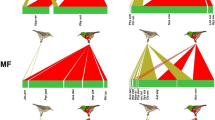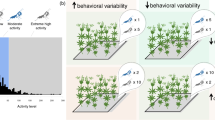Abstract
Predation and dispersal ability of predators can influence their post-release establishment. As physiological factors may influence the predation and dispersal behavior of insects, we tested the effects of starvation on the predation and dispersal behavior of an omnivorous predator Arma chinensis under different prey densities. Logistic regression showed that A. chinensis exhibited a Holling’s Type II functional response regardless of its hunger level. Starvation significantly increased attack rate and reduced prey handling time of A. chinensis. When prey density was low (3 and 6 per plant) A. chinensis that has been starved for 2 and 4 days consumed significantly more second instar Mythimna separata than satiated ones. No significant difference was found in prey consumption among predators of different hunger levels when prey density was high (>12 per plant). When M. separata was absent, starved A. chinensis dispersed faster and spent less time in the target patch; and less than 50% of individuals remained on the plant. When M. separata was available, A. chinensis spent significantly more time in the target patch, and more than 80% of individuals were uniformly distributed on plant seedlings. Hunger level showed more effects on the dispersal of A. chinensis when prey was absent than when prey was available. The implications of these results for the use of A. chinensis in augmentative biological control programs are discussed.





Similar content being viewed by others
References
Alvarado P, Balta O, Alomar O (1997) Efficiency of four Heteroptera as predators of Aphis gossypii and Macrosiphum euphorbiae (Hom.: Aphididae). Entomophaga 42:215–226
Charnov EL (1976) Optimal foraging, marginal value theorem. Theor Popul Biol 9:129–136
Crowder DW, Northfield TD, Strand MR, Snyder WE (2010) Organic agriculture promotes evenness and natural pest control. Nature 466:109–112
Enkegaard A, Brodsgaard HF, Hansen DL (2001) Macrolophus caliginosus: functional response to whiteflies and preference and switching capacity between whiteflies and spider mites. Entomol Exp Appl 101:81–88
Ernsting G (1977) Effects of food deprivation and type of prey on predation by Notiophilus biguttatus F. (Carabidae) on springtails (Collembola). Oecologia 31:13–20
Ettifouri M, Ferran A (2011) Influence d'une alimentation prealable et du jeune sur l'apparition de la recherche intensive des proies chez Semiadalia undecimnotata. Entomol Exp Appl 65:101–111
Foglar H, Malausa J, Wajnberg E (1990) The functional response and preference of Macrolophus caliginosus (Hemiptera: Miridae) for two of its prey: Myzus persicae and Tetranuchus urticae. Entomophaga 35:465–474
Gergs A, Jager T (2014) Body size-mediated starvation resistance in an insect predator. J Anim Ecol 83:758–768
Ghazy NA, Osakabe M, Aboshi T, Mori N, Amano H (2015) The effects of prestarvation diet on starvation tolerance of the predatory mite Neoseiulus californicus, (Acari: Phytoseiidae). Physiol Entomol 40:296–303
Gillespie DR, Vanlaerhoven SL, Mcgregor RR, Chan S, Roitberg BD (2012) Plant feeding in an omnivorous mirid, Dicyphus hesperus: why plant context matters. Psyche A J Entomol:10: 1–10:12
Gui LY, Boiteau G (2010) Effect of food deprivation on the ambulatory movement of the Colorado potato beetle, Leptinotarsa decemlineata. Entomol Exp Appl 134:138–145
Hamdan AJS (2006) Functional and numerical responses of the predatory bug, Macrolophus caliginosus Wagner fed on different densities of eggs of the greenhouse whitefly, Triaeurodes vaporariorum (Westwood). J Biol Res 6:147–154
Hassanpour M, Maghami R, Rafiee-Dastjerdi H, Golizadeh A, Yazdanian M, Enkegaard A (2015) Predation activity of Chrysoperla carnea, (Neuroptera: Chrysopidae) upon Aphis fabae, (Hemiptera: Aphididae): effect of different hunger levels. J Asia Pac Entomol 18:297–302
Heinz KM (1998) Dispersal and dispersion of aphids (Homoptera: Aphididae) and selected natural enemies in spatially subdivided greenhouse environments. Environmental Entomology 27:1029–1038
Heimpel GE, Asplen MK (2011) A ‘goldilocks’ hypothesis for dispersal of biological control agents. Biocontrol 56:441–450
Hénaut Y, Alauzet C, Lambin M (2002) Effects of starvation on the search path characteristics of Orius majusculus (Reuter) (Het. Anthocoridae). J Appl Entomol 126:501–503
Holling CS (1959) Some characteristics of simple types of predation and parasitism. Can Entomol 91:385–398
Hougardy E, Mills NJ (2006) The influence of host deprivation and egg expenditure on the rate of dispersal of a parasitoid following field release. Biol Control 37:206–213
Lamine K, Lambin M, Alauzet C (2005) Effect of starvation on the searching path of the predatory bug Deraeocoris lutescens. Biocontrol 50:717–727
Lampropoulos PD, Perdikis DC, Fantinou AA (2013) Are multiple predator effects directed by prey availability? Basic Appl Ecol 14:605–613
Li Y, Li Z, Yang Y, Yang Q, Liu X, Zhang Q (2015) Impact of food diversity on biological parameters of Apolygus lucorum (Hemiptera: Heteroptera: Miridae). Fla Entomol 98:1188–1192
Li HK, Zhang Z, Kim K, Huang Q, Lei C (2017) Antennal and behavioral responses of Mythimna separata, (walker) to three plant volatiles. Envir Sci Pollut Res Int 24:24953–24964
Maselou D, Perdikis D, Fantinou A (2015) Effect of hunger level on prey consumption and functional response of the predator Macrolophus pygmaeus. B Insectol 68:211–218
Montserrat ML, Albajes R, Castane C (2000) Functional response of four heteropteran predators preying on greenhouse whiteflies (Homopteran: Aleyrodidae) and western flower thrips (Thysanoptera: Thripidae). Environ Entomol 29:1075–1082
Palevsky E, Reuveny H, Okonis O, Gerson U (1999) Comparative behavioural studies of larval and adult stages on the Phytoseiids (Acari: Mesostigmata) Typhlodromus athiasae and Neoseiulus californicus. Exp Appl Acarol 23:467–485
Pearson REG, Behmer ST, Gruner DS, Denno RF (2011) Effects of diet quality on performance and nutrient regulation in an omnivorous katydid. Ecol Entomol 36:471–479
Reisenman CE (2014) Hunger is the best spice: effects of starvation in the antennal responses of the blood-sucking bug Rhodnius prolixus. J Insect Physiol 71:8–13
Rossi MN, Reigada C, Godoy WAC (2006) The effect of hunger level on predation dynamics in the spider Nesticodes rufipes: a functional response study. Ecol Res 21:617–623
Scharf I (2016) The multifaceted effects of starvation on arthropod behaviour. Anim Behav 119:37–48
Schöning C, Shepard L, Sen A, Kinuthia W, Ogutu JO (2011) Should I stay or should I go now? Patch use by African army ant colonies in relation to food availability and predation. Insect Soc 58:335–343
Timms JE, Oliver TH, Straw NA, Leather SR (2008) The effects of host plant on the coccinellid functional response: is the conifer specialist Aphidecta obliterata (L.) (Coleoptera: Coccinellidae) better adapted to spruce than the generalist Adalia bipunctata (L.) (Coleoptera: Coccinellidae)? Biol Control 47:273–281
Toyoshima S, Michalik P, Talarico G, Klann AE, Alberti G (2009) Effects of starvation on reproduction of the predacious mite Neoseiulus californicus (Acari: Phytoseiidae). Exp Appl Acarol 47:235–247
Van Joan B, Boivin G, Outreman Y (2005) Patch exploitation strategy by an egg parasitoid in constant or variable environment. Ecol Entomol 30:502–509
Xiao Y, Fadamiro HY (2010) Functional responses and prey-stage preferences of three species of predacious mites (Acari: Phytoseiidae) on citrus red mite, Panonychus citri (Acari: Tetranychidae). Biol Control 53:345–352
Zappalà L, Campolo O, Grande SB, Saraceno F, Biondi A, Siscaro G (2013) Dispersal of Aphytis melinus (Hymenoptera: Aphelinidae) after augmentative releases in citrus orchards. Eur J Entomol 109:561–568
Zou DY, Coudron TA, Wu HH, Gu XS, Xu WH, Zhang LS, Chen HY (2015) Performance and cost comparisons for continuous rearing of Arma chinensis (Hemiptera: Pentatomidae: Asopinae) on a zoophytogenous artificial diet and a secondary prey. J Econ Entomol 108:454–461
Acknowledgments
We are grateful for the assistance of all staff and students in the Sino-American Biological Control Laboratory, Institute of plant protection in Beijing, China. This work was supported by The National Key Research and Development Program of China (2017YFD0201000, 2017YFE0104900), The Project of International Cooperation of Ministry of Agricultural, China (2016-X48), Sino-America BioControl International Cooperation Program (58-4001-4-053), Open Fund of Key Laboratory of Integrated Pest Management on Crops in Northwestern Loess Plateau, Ministry of Agriculture (KFJJ20180106).
Author information
Authors and Affiliations
Contributions
MZP, LSZ and HYC design the research.
MZP and HPZ conducted experiments.
MZP analyzed data and wrote the manuscript.
Corresponding author
Ethics declarations
Conflict of Interest
The authors declare that they have no conflict of interest.
Additional information
Publisher’s note
Springer Nature remains neutral with regard to jurisdictional claims in published maps and institutional affiliations.
Rights and permissions
About this article
Cite this article
Pan, M., Zhang, H., Zhang, L. et al. Effects of Starvation and Prey Availability on Predation and Dispersal of an Omnivorous Predator Arma chinensis Fallou. J Insect Behav 32, 134–144 (2019). https://doi.org/10.1007/s10905-019-09718-9
Received:
Revised:
Accepted:
Published:
Issue Date:
DOI: https://doi.org/10.1007/s10905-019-09718-9




